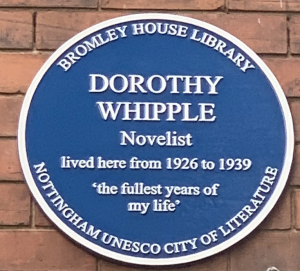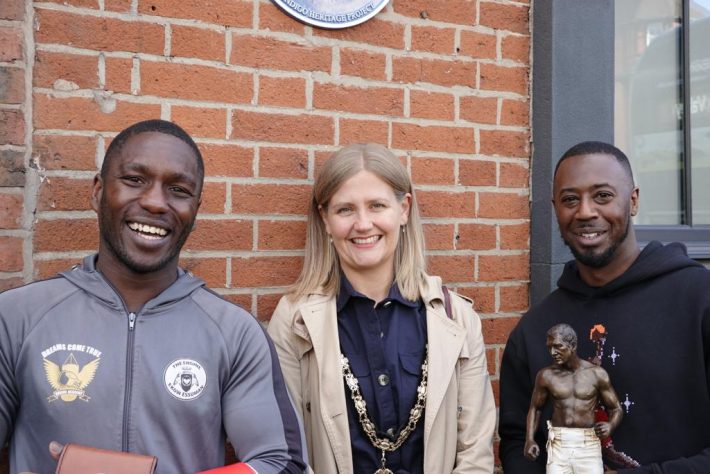Civic plaques are a popular way of remembering our history and people. The Mapperley area doesn’t seem to have many though. Why is this?
Nottingham city centre has many, and so does the Beeston area. Surely our area has people and places that are worth commemorating.
Postcode Lottery?
Mapperley People considers Mapperley to be the area covered by postcodes NG3 – 5. This represents a significant community and area to the north-east of the city, but there are hardly any plaques. Not even in Arnold it seems, where there is an active Local History group.
There is one plaque that does spring to mind, and that is the one that commemorates the author Stanley Middleton. This was installed at the house in Sherwood where he lived from 1961. Stanley Middleton also taught at High Pavement Grammar School in Bestwood.
Born in Bulwell, the son of a railway worker, Stanley Middleton was an acclaimed novelist who lived in Nottingham most of his life. Nearly all of Stanley’s 45 novels were set in or around Nottingham. One of them, Holiday, shared the Booker Prize in 1974.

In 2019, the people involved with the City of Literature and the Civic Society installed a plaque on the front of his former home, 42, Caledon Rd, Sherwood, Nottingham (NG5 2NG).

Dorothy Whipple
Dorothy was another renowned author who lived on Ebers Road in Mapperley Park. A plaque was installed last year.
Two of her books were made into films – They Knew Mr Knight and They Were sisters. She wrote about ordinary lives but with subtly feminist themes of women striving for independence. J B Priestley called her the Jane Austen of the twentieth century. Her writing went out of fashion after her death but there has been a resurgence of interest in her books and Persephone Books have republished all of her novels.
Dorothy was born in Blackburn in 1893 and came to Nottingham after her marriage. It was from the house in Ebers Road that her first novel Young Anne was written and by the time she left in 1939 six more novels had been published. She loved her time in Ebers Road saying ‘I felt miserable … parting with this house where I have been so happy, so much has happened to me during the fourteen years I have lived in it. These have been, I am sure, the fullest years of my life.’

Sporting Heroes
We have many sporting success stories to draw on, yet the only plaque seems to be one relating to Bendigo the famous 19th century boxer.
In 2022, there was a plaque installed at The Forest Tavern on Mansfield Road. The former public house (circa 1830) is strongly associated with Bendigo of Nottingham who was the undefeated Champion of all England.

The Forest Tavern is near the Rock Cemetery. Whilst this location doesn’t have an NG3 postcode, it is close to St Andrew’s Church at the junction on Mapperley Road, which does so we’ll include that one. Bendigo is also known to have fought near to the Travellers Rest on Mapperley Plains

The Mayor of Nottingham with boxers Ekowe Essuman and Barrington Brown at the unveiling of the plaque in 2022
Who else is being considered worthy of a Civic Plaque?
George Powe
George Powe was born in Jamaica and served in the RAF during World War II and subsequently settled in the UK. He was probably the first black councillor in the country when elected in 1963 as a Labour Party member in Long Eaton.
In 1969 he was given a place at Nottingham Trent Polytechnic to train as a teacher. He went on to teach mathematics at local schools including Arnold Hill.
George was a councillor for Manvers Ward in Nottingham and was heavily involved in setting up the Afro-Caribbean National Artistic Centre which opened in St. Anns in 1978.
There is a campaign to get George Powe a plaque. Details here.
Peter Bowles
Peter Bowles was a renowned actor who lived for a time in Mapperley when his family moved to Nottingham. He was ironically also taught by Stanley Middleton at High Pavement Grammar School. In 1980, Stan talked about Peter’s days at High Pavement when the actor was on This is Your Life
What about buildings with an important local history?
Arnot Hill House, Mapperley Hospital, the Porchester Estate, Woodthorpe Grange, or the site of St Ann’s well to name just a few.
One which was celebrated with a plaque is at the former Gedling Railway Station, although the plaque relates to another author’s connection to it.
In September 1914, JRR Tolkien visited his Aunt Jane Neave, who lived at Phoenix Farm on Arnold Lane. He came by train and arrived at Gedling Train Station. Whilst staying on the farm, he wrote ‘The Voyage of Earendel the Evening Star’; a poem which started the authors voyage into mythological literature where hobbits and fairies existed in the distant lands of Mordor, Middle Earth and Rivendell.

We would be interested in any suggestions or information about other worthy locations.

